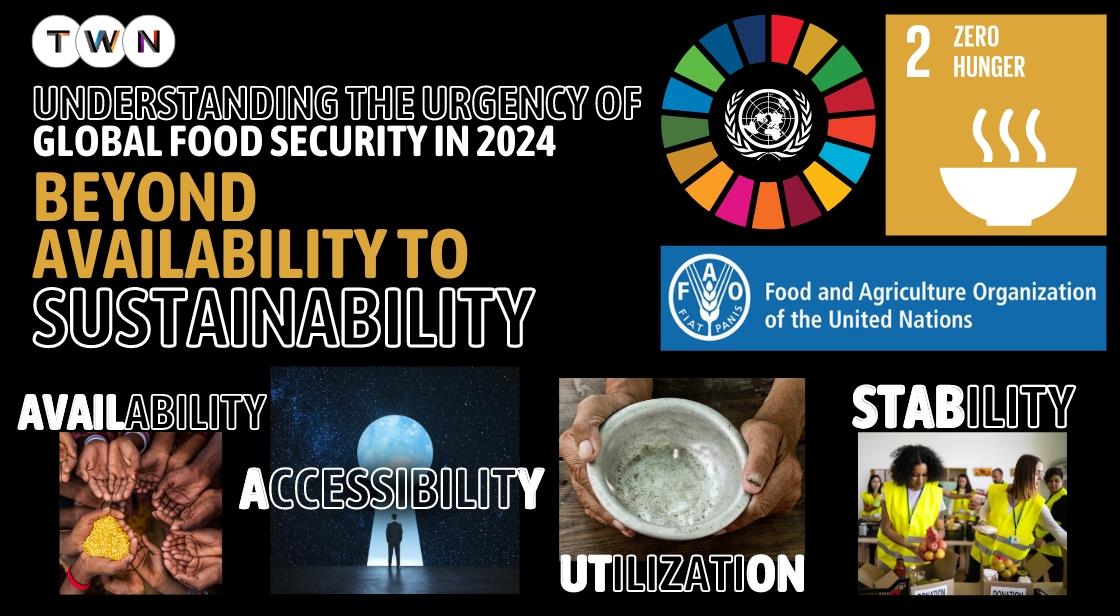Understanding the Urgency of Global Food Security in 2024: Beyond Availability to Sustainability

Blog Post
Over 2.4 billion people, almost 30% of the global population, faced moderate to severe food insecurity in 2022. This staggering statistic highlights the critical issue of global food security, a complex challenge intertwined with climate change, conflict, economic inequality, and population growth.
While progress has been made in recent years, significant setbacks and emerging threats demand immediate attention and collaborative action.
This comprehensive guide delves into the multifaceted world of food security, providing a clear understanding of its core pillars: availability, accessibility, utilization, and stability. We explore the latest data and trends, shedding light on both challenges and promising solutions.
From innovative technologies like AI-powered farming to empowering local communities through farmer-led cooperatives, we showcase diverse efforts tackling food insecurity at various levels.
Beyond simply having enough food available, this report emphasizes the importance of affordability, a growing concern with rising food prices impacting access for vulnerable populations.
The crucial role of nutrition in ensuring healthy lives is also addressed, highlighting the fight against "hidden hunger" caused by micronutrient deficiencies.
Furthermore, we examine the global policy landscape, analyzing frameworks like the Sustainable Development Goals and exploring ongoing discussions on trade, resource mobilization, and policy innovation.
By understanding the complexities involved, we empower ourselves to advocate for effective solutions and contribute to a world where everyone has access to safe, nutritious food.
Join us on this journey to unravel the challenges and explore the opportunities in tackling global food security.
"Let's work together to create a future where food is not a privilege, but a fundamental right for all."
Why is global food security important ? A Comprehensive Overview
What is food security?
Food security goes beyond simply having enough food available. It encompasses a complex interplay of factors guaranteeing everyone, everywhere, has access to sufficient, nutritious, and culturally acceptable food for an active and healthy life. Here's a deeper dive into this critical concept:
Exploring the Four Pillars of food security:
The Food and Agriculture Organization (FAO) defines food security through four key pillars:
-
Availability: Food must be physically produced in sufficient quantities, accessible geographically, and resilient to climate shocks. Examples include diversifying crops, investing in sustainable farming practices, and reducing food waste.
-
Accessibility: People must have the economic means to acquire the food they need. This involves income security, fair market prices, and accessible food distribution systems. Examples include social safety nets, minimum wage policies, and local food markets.
-
Utilization: Food must be properly utilized for optimal nutrition. This involves knowledge of healthy eating, access to clean water and sanitation, and addressing malnutrition, particularly in children and vulnerable populations. Examples include nutrition education programs, fortification of staple foods, and access to healthcare.
-
Stability: Food security should be consistent and not threatened by shocks or crises. This requires building resilience to climate change, conflict, and economic instability. Examples include early warning systems for natural disasters, conflict resolution programs, and diversified food sources.
Recent Developments and Global Concerns on global food security:
Despite significant progress, global food security faces challenges:
-
Climate change: Extreme weather events and rising temperatures disrupt agricultural production, impacting food availability and affordability.
-
Conflict and displacement: Wars and civil unrest disrupt food systems and force people from their homes, leading to food insecurity.
-
Economic inequality: Unequal access to resources and income limits access to nutritious food for many.
-
Population growth: Meeting the needs of a growing population adds pressure on food production systems.
Examples of Global Efforts of food security:
-
The Sustainable Development Goals (SDGs), particularly SDG 2 (Zero Hunger), aim to achieve food security by 2030.
-
The World Food Programme (WFP) provides emergency food assistance and supports long-term food security interventions.
-
The International Fund for Agricultural Development (IFAD) invests in small-scale farmers to improve food production and access to markets.
Beyond the SDGs: Diverse Efforts Fueling the Fight for Global Food Security
While the Sustainable Development Goals (SDGs), particularly SDG 2 (Zero Hunger), play a pivotal role in the fight for global food security, numerous other initiatives and organizations are tackling this complex challenge from various angles. Here's a glimpse into the diverse efforts shaping a food-secure future:
Tech-Driven Solutions:
-
AI-powered farming: Harnessing artificial intelligence to optimize crop yields, predict market fluctuations, and suggest resource-efficient practices. For example, IBM's "Food Trust" platform leverages AI to track food provenance and combat food fraud.
-
Vertical farming: Cultivating crops indoors under controlled conditions, particularly in urban areas with limited land. Companies like AeroFarms are leading the way, providing fresh produce year-round with minimized water usage.
-
Precision agriculture: Utilizing drones, sensors, and satellite imagery to provide farmers with real-time data on soil health, water needs, and potential pest outbreaks, enabling targeted interventions and maximizing resource efficiency.
Empowering Local Communities:
-
Farmer-led cooperatives: Strengthening smallholder farmers' bargaining power, access to resources, and market opportunities. Organizations like Fairtrade International promote fair trade practices that empower farmers and ensure sustainable livelihoods.
-
Indigenous food systems: Reviving traditional agricultural practices and knowledge adapted to local contexts and promoting sustainable food production. The International Fund for Indigenous Peoples' Development (IFAD) supports projects that revitalize indigenous food systems and conserve biodiversity.
-
Women-led initiatives: Investing in women farmers, who play a crucial role in food production and household food security, particularly in developing countries. The UN Women's "Empowering Women in Agriculture" program provides training, resources, and market access to women farmers.
Addressing Specific Challenges:
-
Fighting "Hidden Hunger": Addressing micronutrient deficiencies, often overlooked but critical for health and development, through biofortification of staple crops. The HarvestPlus organization breeds crops naturally enriched with essential vitamins and minerals.
-
Combating food waste: Reducing food waste throughout the supply chain, from post-harvest losses to consumer behavior, to conserve resources and improve food security. The Food and Agriculture Organization (FAO) spearheads the "Save Food Initiative" to build awareness and promote food waste reduction strategies.
-
Building resilience to climate shocks: Investing in early warning systems, drought-resistant crops, and climate-resilient infrastructure to mitigate the impact of climate change on food production. The CGIAR Research Program on Climate Change, Agriculture and Food Security (CCAFS) develops solutions to help farmers adapt to and build resilience against climate change.
Remember: Achieving global food security demands a collaborative approach, combining traditional methods with innovative solutions, addressing specific challenges, and empowering local communities. This diverse landscape of efforts offers hope for a future where everyone has access to safe, nutritious food.
Taking Action:
Individuals and communities can contribute to food security by:
-
Supporting sustainable agriculture practices.
-
Reducing food waste at home and in businesses.
-
Advocating for policies that promote food security.
-
Choosing food sources that support fair trade and local farmers.
-
Educating ourselves and others about food security challenges and solutions.
By understanding the complexities of food security and taking collective action, we can work towards a world where everyone has access to healthy and nutritious food.
Also Read : Understanding the Environmental Cost of Our Diet: Foods with Major Ecological Footprints
Why is food safety important?
Beyond Hunger: Why Food Safety Matters More Than Ever
While hunger and food insecurity are deeply concerning issues, food safety plays a crucial role in ensuring overall well-being, impacting individuals, communities, and economies globally. Here's why food safety deserves our unwavering attention:
Protecting Health and Lives:
-
Foodborne illnesses: Unsafe food contaminated with bacteria, viruses, parasites, or chemicals can cause foodborne illnesses, leading to diarrhea, vomiting, and even death. The World Health Organization estimates that 1 in 10 people fall ill and 420,000 die annually due to unsafe food.
-
Chronic health risks: Exposure to harmful substances in food can contribute to chronic illnesses like cancer, kidney disease, and developmental disorders.
Economic Impact:
-
Lost productivity: Foodborne illnesses lead to lost workdays, healthcare costs, and reduced productivity, costing economies billions of dollars annually.
-
Trade disruptions: Food safety concerns can lead to trade restrictions and export bans, impacting farmers, businesses, and national economies.
Vulnerable Populations:
-
Children and pregnant women: Young children and pregnant women are particularly susceptible to foodborne illnesses due to their developing immune systems.
-
Low-income communities: Limited access to safe food options and proper hygiene facilities disproportionately impact these communities.
Examples of Food Safety Breaches:
-
In 2022, a global salmonella outbreak linked to Kinder chocolate products affected over 90 countries.
-
Contaminated lettuce caused an E. coli outbreak in the United States in 2019, sickening hundreds and leading to multiple deaths.
Importance of Global Collaboration:
-
FAO and WHO: The Food and Agriculture Organization (FAO) and World Health Organization (WHO) collaborate on the Codex Alimentarius, setting international food safety standards.
-
Global Food Safety Partnership: This multi-stakeholder initiative works to strengthen food safety systems worldwide.
What We Can Do:
-
Consumers: Practice safe food handling at home, purchase from reliable sources, and stay informed about recalls.
-
Businesses: Implement robust food safety measures, adhere to regulations, and prioritize transparency.
-
Governments: Invest in food safety infrastructure, regulations, and enforcement, and support small-scale farmers.
Beyond the Right to Food:
While access to adequate food is crucial, ensuring its safety is equally important for individual and collective well-being. By prioritizing food safety, we can safeguard health, economies, and create a more sustainable future where everyone thrives.
Consumers expect to be protected from hazards along the entire food chain from farms and fields to table. Conservation will only be achieved if all sectors of the chain work in an integrated manner and food control systems address all stages of the chain.
International trade in fresh and processed food will continue to grow with the expanding world economy, liberalization of food trade, increased consumer demand, advances in food science and technology, and advances in transportation and communications. This has increased concerns about food security.
The food industry can directly impact human health and hence ensuring food safety and hygiene is of utmost importance as it helps protect the health of consumers from foodborne illness and food poisoning.
Food poisoning occurs when food becomes contaminated with bacteria, viruses, and other microbes, causing those who consume the contaminated food to become ill. While food poisoning is often manageable through home remedies, there are instances where it can pose serious health risks, necessitating prompt medical attention. As a result, consumers should exercise caution and be mindful of the potential severity of food poisoning.
Confidence in the safety and integrity of the food supply is an important need for consumers. Foodborne disease outbreaks involving agents such as Escherichia coli, Salmonella, and chemical contaminants highlight problems with food safety and increase public concern that modern farming systems, food processing, and marketing do not provide adequate protection for public health.
Factors that contribute to potential hazards in food include improper agricultural practices; poor sanitation at all stages of the food chain; lack of preventive controls in food processing and preparation; misuse of chemicals; contaminated raw materials, components, and water; Inadequate or improper storage, etc.
Current food safety regulations require food businesses to carry out their food duties safely and hygienically. Supplying unhealthy food to consumers is an offense. Food businesses are responsible for taking care when supplying food to consumers, and food safety and food hygiene are of the highest priority.
Considering the global food trade, even the slightest negativity at any stage of production can affect the health of people on the other side of the world. Therefore, today food security is a global issue.
For all these reasons, applying the principles of the Food Safety System (FSS) contributes to the performance and reliability of companies.
Also Read: Tips for Maintaining Healthy Soil and Growing Nutrient-Rich Food: Sustainable Agriculture
Why is global Food Security Important for India?
Food security is an important issue for India. This reflects the need to face all the challenges that may arise in different sectors of the food chain. Here are some main reasons:
1. Population Pressure:
India's huge population and number of undernourished people is a major challenge for food security.
2. Agricultural Productivity:
Agricultural productivity is low in the agricultural sector due to fragmented land, inadequate irrigation facilities, lack of modern agricultural techniques and limited access to credit and technology.
3. Climate change and natural disasters:
Irregular weather patterns, drought, flooding, extreme temperatures, and other conditions can affect food productivity.
4. Land degradation and soil health:
Improper land management and use of chemical fertilizers are causing land degradation.
5. Storage and Delivery:
Inefficient storage facilities and inadequate cold chain systems can result in substantial food losses.
Navigating the Complexities of Global Food Security Policy: A Current Landscape
Global food security, ensuring everyone has access to safe and nutritious food, remains a complex issue requiring nuanced policies at various levels. Here is a summary of the present scenario:
Key Policy Frameworks:
-
Sustainable Development Goals (SDGs): SDG 2, "Zero Hunger," is the primary framework, aiming to eradicate hunger by 2030. It encourages global collaboration and national-level action across multiple areas.
-
World Food Programme (WFP): This UN agency provides emergency food assistance and supports long-term food security interventions, advocating for policy changes that address root causes of hunger.
-
Food and Agriculture Organization (FAO): The FAO leads the global fight against hunger through various initiatives, including policy analysis, technical assistance, and standard-setting.
Focus Areas and Debates:
-
Trade and Agriculture: Balancing free trade with protecting domestic agricultural production raises complex policy challenges. Debates surround subsidies, tariffs, and fair trade agreements.
-
Climate Change Adaptation: Building resilience to climate change's impact on food systems is crucial. Policies focus on drought-resistant crops, early warning systems, and climate-smart agriculture practices.
-
Sustainable Food Systems: Promoting sustainable production and consumption patterns is vital for long-term food security. Policies encourage resource efficiency, reduced food waste, and dietary shifts.
-
Gender Equality and Empowerment: Women play a critical role in food security, but face discrimination and limited access to resources. Policies promote gender equality in land ownership, access to financing, and decision-making.
Emerging Trends and Policy Innovations:
-
Tech-driven solutions: Blockchain for food traceability, AI-powered farming tools, and vertical farming are shaping policy discussions around data governance, digital access, and regulatory frameworks.
-
Private sector engagement: Collaboration between governments, businesses, and civil society organizations is increasingly recognized as critical. Policies incentivize private investments in sustainable agriculture and food security initiatives.
-
Community-based approaches: Empowering local communities through farmer-led cooperatives, indigenous knowledge revitalization, and participatory decision-making is gaining traction in policy discourse.
Challenges and Ongoing Discussions:
-
Resource mobilization: Sufficient funding remains a key hurdle. Innovative financing mechanisms like impact investing and climate-smart agriculture bonds are being explored.
-
Monitoring and evaluation: Measuring the effectiveness of various policies and interventions is crucial for adapting and improving strategies.
-
Addressing political and economic inequalities: Food security is deeply intertwined with broader issues like poverty, conflict, and political instability. Inclusive and equitable policies are essential for sustainable solutions.
Understanding the current landscape of global food security policy is crucial for engaging in informed discussions and advocating for effective solutions. This multifaceted issue requires diverse stakeholders working together to ensure a food-secure future for all.
What are the main points in the policy of global food security?
The following are the main points of Global food security policy:
1. Global Hunger:
Global hunger remains stable between 2021 and 2022 The number of people facing hunger worldwide has increased by more than 122 million since 2019 due to the pandemic, climate change, and conflicts including the war in Ukraine.
2. Access to nutritious food:
The year 2022 sees a persistent decline in access to nutritious, safe, and adequate food for approximately 2.4 billion individuals, primarily women and residents of rural areas.
3. Child Malnutrition:
The situation of child malnutrition remains worrying. In 2021, 22.3% (148.1 million) children were stunted, 6.8% (45 million) were wasted and 5.6% (37 million) were overweight.
4. Impact of urbanization on diet:
Accelerating urbanization leads to a significant increase in the consumption of processed and convenience foods, leading to increased rates of overweight and obese populations in urban, peri-urban, and rural areas.
What are the challenges to global food security?
Addressing global food security is a complex endeavor, and many challenges need to be addressed:
1. Climate change:
Erratic weather patterns, extreme temperatures, and natural disasters affect crop yields and food production. Adaptation strategies are critical to reducing climate-related risks.
2. Population Growth:
While population growth is a key factor, other trends like rising incomes and dietary shifts also contribute to increasing food demand.
3. Shortage of resources:
Limited cultivable land, lack of water, and soil erosion affect agricultural productivity. Continuous resource management is necessary.
4. Poverty and inequality:
Many vulnerable populations lack access to nutritious food due to poverty and income inequalities. Addressing inequality is important for food security.
5. Struggle and instability:
War, civil unrest and displacement disrupt food supply chains, increasing hunger and malnutrition.
6. Food Wastage and Loss:
A large quantity of food is wasted during production, distribution and consumption. Reducing waste can increase the availability of food.
7. Market access and trade barriers:
Unequal trade policies, tariffs, and transportation challenges hinder food delivery across borders.
8. Nutrition Deficiency:
Food security isn't just about quantity; It's about quality also. It is essential to ensure access to a diverse, nutritious diet.
9. Technology lag:
Lack of access to modern farming technologies and practices limits productivity gains in some areas.
10. Policy coordination:
Coordination of efforts among governments, organizations and stakeholders is critical for effective food security policies.
Some efforts of India for global food security
1. Eat Right India:
It is a joint effort of the Government of India and FSSAI to improve the food system to ensure safe, healthy, and sustainable food for Indians. It mainly focuses on the areas of local food governance, food security, epidemiology, fundamental rights, and consumer protection.
Health Minister Harsh Vardhan stressed moving from food security to nutrition security to achieve the goals of the 'Eat Right India Movement' and appealed to other line ministries to create a common platform to set common objectives and strategies. Harsh Vardhan chaired the inter-ministerial meeting of FSSAI and senior officials of various ministries to take a ‘whole of government’ approach to achieve the ‘Vision 2050’ of the Eat Right India Movement.
The health ministry said in a statement that the minister took cognizance of the economic burden of foodborne diseases in India, which is estimated to be about $15 billion.
According to the statement, Harsh Vardhan said that to move from food security to nutrition security, the concerned ministries should come together so that common goals and strategies can be created by creating a common platform and their work can be coordinated accordingly.
He said, “Various ministries can do important work regarding primary production, food processing, their regulation in terms of spoilage and cleanliness and consumption. Only then ‘Eat Right India’ will be a true movement.
2. Mid-day Meal Scheme:
The Mid Day Meal Scheme is a well-intentioned program which aims to provide at least one nutritionally adequate meal per day (lunch) to underprivileged children.
Under the Mid-Day Meal Scheme, cooked meals with specified nutritional values are provided to children in the age group of 6 to 14 years who are studying in government or government-aided schools.
In order to improve the implementation of this scheme, many state governments have introduced various practices. For example, states like Karnataka and Andhra Pradesh introduced a practice called kitchen gardens where vegetables and fruits required for cooking are cultivated within the school premises.
3.National Food Security Act (NFSA):
This act was passed in 2013 and is the most important food safety law in India. It includes necessary measures to ensure the availability of safe, healthy, and nutritious foods. Under this law, there is a provision to provide food grains at subsidized rates to up to 75 percent of the population in rural areas and up to 50 percent of the population in urban areas under the Targeted Public Distribution System (TPDS).
Thus, about two-thirds of the country's population is expected to benefit from it.
1. 5 Kg per month to eligible families. Rice, wheat, and coarse grains cost Rs 3, 2, and 1 per kg respectively. Will be available at a discounted rate.
2. The families covered under the Antyodaya Anna Yojana (AAY) will get 35 kg of food per family. The availability of food grains will continue as before.
3. Eligible families will be selected to receive subsidized food grains under the Targeted Public Distribution System (TPDS) for 365 days after its implementation.
4. Apart from food, pregnant and lactating women will also get a maternity benefit of at least Rs 6000 during pregnancy and six months after delivery.
5. Children up to 14 years of age can take home nutritious food or ration as per prescribed nutritional norms.
6. In case of non-supply of food grains or food, the beneficiary will be given a food security allowance.
7. There is also a provision in this Act to establish a grievance redressal mechanism at the district and state levels.
8. Required provisions have also been made to ensure transparency and accountability.
4. World Food Safety Day
World Health Protection Day is observed every year on 7 June. The purpose of celebrating this day is to create awareness among food producers, consumers, and the government about food safety. According to the World Health Organization (WHO), every year one in 10 people globally falls ill after eating contaminated food. No country is untouched by this.
More than 200 diseases are caused by the presence of bacteria, viruses, parasites, and chemicals in food. For this reason, emphasis is laid on paying attention to food security. Celebrating this day was started by the WHO and Food and Agriculture Organization (FAO) in 2018. One of the reasons to celebrate this day is to make people aware of the importance of food safety.
What is the latest strategy for global food security?
On the issue of global food security, the US State Department has issued a joint statement including EU High Representative Josep Borrell, US Secretary of State Antony J. Blinken, and Britain's Secretary of State James Cleverly. This statement highlights the need to address serious challenges related to food and nutrition.
These challenges are heightened by climate change, which is having a devastating impact on people, and the long-term impact of COVID-19. Additionally, Russia's unprovoked attack on Ukraine has further aggravated food security. The EU, along with the US, the UK, and other members, are leading global efforts to tackle food insecurity.
Conclusion
However, the development of the global food system has been slow due to structural challenges. During the year, affordability (the top-scoring pillar) went down due to a sharp increase in food inflation, decreased trade freedom, and reduced funding for food security. In Europe, countries such as Finland, Ireland, and Norway received high marks for widening the food security gap. South Africa is the most food-secure country in Africa.
You May Like
EDITOR’S CHOICE












